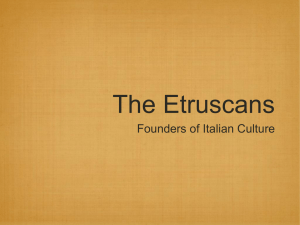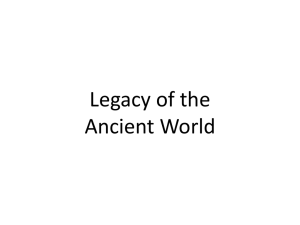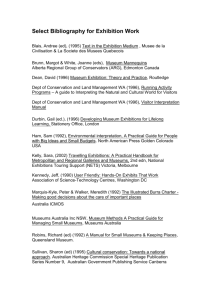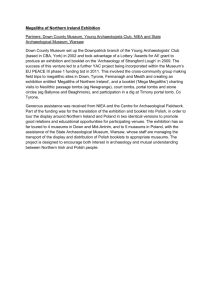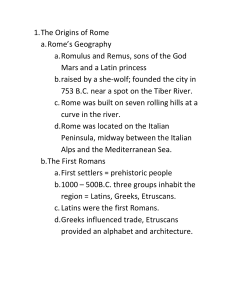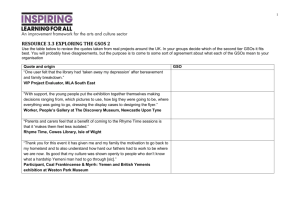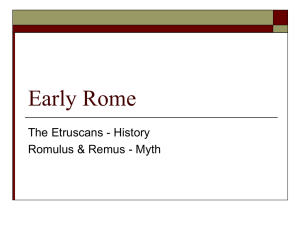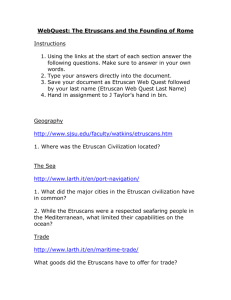The Etruscans - Una storia particolare - Gallo
advertisement
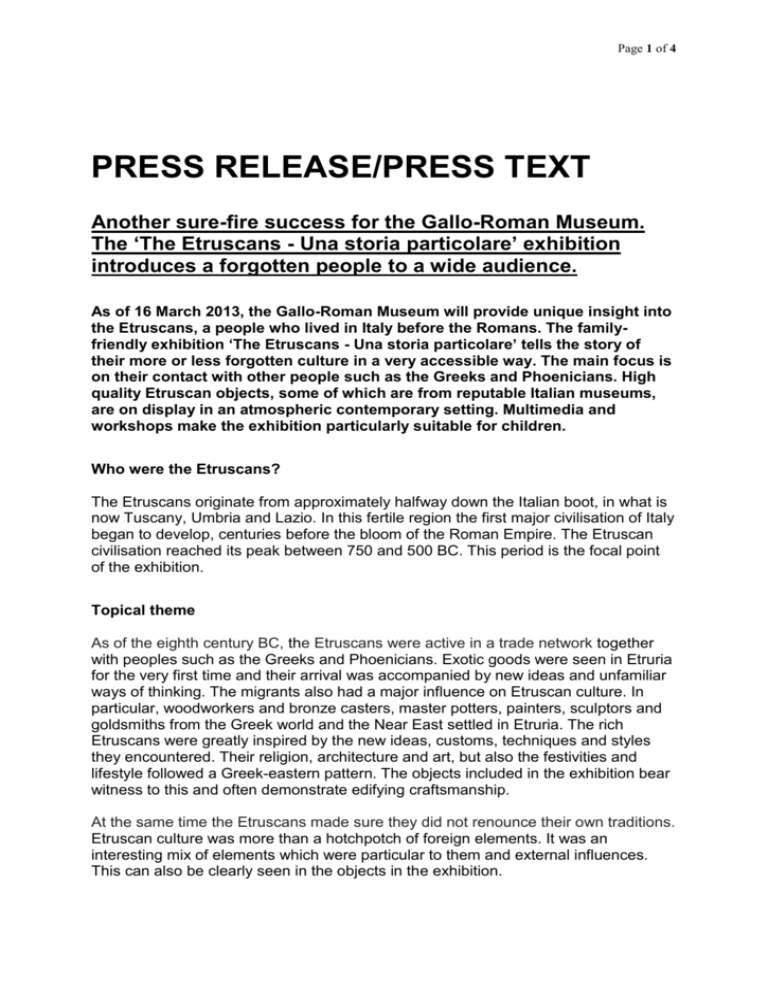
Page 1 of 4 PRESS RELEASE/PRESS TEXT Another sure-fire success for the Gallo-Roman Museum. The ‘The Etruscans - Una storia particolare’ exhibition introduces a forgotten people to a wide audience. As of 16 March 2013, the Gallo-Roman Museum will provide unique insight into the Etruscans, a people who lived in Italy before the Romans. The familyfriendly exhibition ‘The Etruscans - Una storia particolare’ tells the story of their more or less forgotten culture in a very accessible way. The main focus is on their contact with other people such as the Greeks and Phoenicians. High quality Etruscan objects, some of which are from reputable Italian museums, are on display in an atmospheric contemporary setting. Multimedia and workshops make the exhibition particularly suitable for children. Who were the Etruscans? The Etruscans originate from approximately halfway down the Italian boot, in what is now Tuscany, Umbria and Lazio. In this fertile region the first major civilisation of Italy began to develop, centuries before the bloom of the Roman Empire. The Etruscan civilisation reached its peak between 750 and 500 BC. This period is the focal point of the exhibition. Topical theme As of the eighth century BC, the Etruscans were active in a trade network together with peoples such as the Greeks and Phoenicians. Exotic goods were seen in Etruria for the very first time and their arrival was accompanied by new ideas and unfamiliar ways of thinking. The migrants also had a major influence on Etruscan culture. In particular, woodworkers and bronze casters, master potters, painters, sculptors and goldsmiths from the Greek world and the Near East settled in Etruria. The rich Etruscans were greatly inspired by the new ideas, customs, techniques and styles they encountered. Their religion, architecture and art, but also the festivities and lifestyle followed a Greek-eastern pattern. The objects included in the exhibition bear witness to this and often demonstrate edifying craftsmanship. At the same time the Etruscans made sure they did not renounce their own traditions. Etruscan culture was more than a hotchpotch of foreign elements. It was an interesting mix of elements which were particular to them and external influences. This can also be clearly seen in the objects in the exhibition. Page 2 of 4 A whole range of objects Almost all the objects originate from tombs of the Etruscan elite. Pottery in many styles and shapes, such as an almost life-size pitcher with oriental painted decorations; crockery including large basins on tripods for the ritual consumption of wine; intricate jewellery decorated with gold thread; tuff stone urns and bronze mirrors with scenes from mythology; svelte sculptures of warriors, gods and funny looking mythical creatures. Some of the most fascinating exhibits come from the Regolini-Galassi tomb, an Etruscan tomb from the 7th century BC which is famous for its exceptionally rich contents. ‘The Etruscans - Una storia particolare’ puts items from the Dutch national Museum of Antiquities in Leiden and the Allard Pierson Museum in Amsterdam on display. The exhibition in Tongeren was developed in collaboration with these museums. There are also many objects from the collections of prestigious museums such as the Vatican and Capitoline museums in Rome, the museum of the Villa Giulia and the archaeological museums of Firenze and Bologna. Objects from the Rheinisches Landesmuseum (Trier) and the Württembergisches Landesmuseum (Stuttgart) will also be shown. As a rear treat objects from the tomb of Eigenbilzen will also be on display in Tongeren. The richest Celtic tomb in Belgium also includes an Etruscan object which can usually be found in the Royal Museum of History and Art in Brussels. Educational and family friendly But the exhibition consists of more than just great works of art. The Etruscan cultural world is made accessible with plenty of film footage. For instance, there are films in which an expert explains the origin of the Etruscans, their unique language and remarkable religious customs such as ‘reading’ a sheep’s liver. The technological craftsmanship of the Etruscans is also demonstrated. Another audiovisual production gives visitors insight into the trade flows and migrations that were common in the Mediterranean world at the time. Finally, visitors can listen to the adventures of the Greek hero Odysseus, with whom the Etruscans were also familiar. Maps and panels with text are of course also included in the exhibition. These have been intentionally kept brief and to-the-point. An audio guide is available for visitors who want to find out more about the objects. There is additional, child-friendly information for twenty of the items. The same information is also available on the audio guide. Target groups are children and youngsters aged between eight and fourteen. They are stimulated to think about modern forms of contact and exchange on the basis of the Etruscan objects. Creative workshops have also been designed especially for them. The main focus is on Etruscan craftsmanship. Children can, for instance, paint an clay vase in the socalled black-figure style and use glue, thread, beads and gold paint to create a personalised oriental jewel. A professional guide supervises the workshops and provides additional information. Page 3 of 4 PRACTICAL Title ‘The Etruscans - Una storia particolare’. Duration 16 march 2013 – 25 august 2013. Opening times Tuesdays to Fridays from 9 am till 5 pm. Saturdays, Sundays, national holidays and (Belgian) school holidays: 10 am – 6 pm. The museum is closed on Mondays, unless that day is a holiday. Admission prices The Etruscans - Una storia particolare Adults: Children and young people aged 4 to 26: Over 55s, the disabled, discount holders and group: Families: € 10,00 € 1,00 € 8,00 € 21,00 The Etruscans - Una storia particolare + permanent exhibition Adults: Children and young people aged 4 to 26: Over 55s, the disabled, discount holders and groups: Families: € 15,00 €1,00 € 10,00 € 31,00 Audio guides are included in the admission price. Trains to the Etruscans An advantageous day trip (B-excursion ‘Etruscans’, no. 526/527) is valid for the train journey there and back, together with admission both to the exhibition and the museum’s permanent collection. Creative workshops for children (6 years or older) Creative workshops take place at weekends, on national holidays and during (Belgian) school holidays, from 2 to 5 pm. The workshops are included in the admission fee. Guided tours Let one of our experienced guides immerse your group in the world of the Etruscans for an hour and a half. A guided tour costs € 50,00 per group, maximum 25 persons. You can follow in the footsteps of The Etruscans with an original wine tasting. You visit to the exhibition will include regular stops to enjoy some of the most delicious Italian wines, chosen by Selezione Vini Italiani (Toni Etneo). Participation costs € 15,00. Page 4 of 4 Information Gallo-Roman Museum Kielenstraat 52, B-3700 Tongeren, Belgium Tel. +32 12 67 03 30 Email: grm@limburg.be www.galloromeinsmuseum.be
